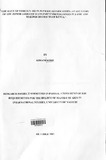| dc.description.abstract | This study examines the role of foreign aid in poverty eradication using two case studies from Kenya's Coast province; the Magarini Settlement project in Malindi district and the GASP (German Assisted Settlement Programme) in Lamu district. In analysing various development initiatives proposed for Africa one hardly finds any that has contributed to sustainable development. In most cases, donor projects have been an island of plenty in the midst of poverty that characterises most rural areas in Africa. Soon these withers and all the resources disappear at the end of such projects and the population relapses back to poverty.
In order to find out whether foreign aid contributed to development in the above case studies, this study compares their project designs and implementation to find out how they both contributed or failed in achieving their objectives of eradicating poverty in the respective districts of implementation. Data has been collected through interviews, project reports and published reports.
Through a detailed case study analysis, we come to the conclusion that it is only through participatory planning, monitoring and evaluation, where decisions are made at joint donor, government and community consultative workshops that meaningful development has been realised. Where donors dismiss the important role of the beneficiaries in the design and implementation of projects, development is not realised .
Tied to this is a people's history and culture. That a people have with time developed certain skills with which to tame nature. These skills cannot be replaced by new ones over night and it's up to the donors and the government representatives to ensure that the integration of the beneficiary community's technology with the proposed one is done with care. Otherwise introducing machines with the hope of adoption by the beneficiaries can produce disastrous results when that technology is rejected by the expected beneficiaries. Community involvement empowers the people and enables beneficiaries to translate foreign aid into sustainable development that they can be proud of long after the donors are gone | en_US |

